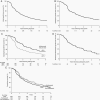Long-term natural history and patterns of sporadic vestibular schwannoma growth: A multi-institutional volumetric analysis of 952 patients
- PMID: 34964894
- PMCID: PMC9340632
- DOI: 10.1093/neuonc/noab303
Long-term natural history and patterns of sporadic vestibular schwannoma growth: A multi-institutional volumetric analysis of 952 patients
Abstract
Background: The current study aims to characterize the natural history of sporadic vestibular schwannoma volumetric tumor growth, including long-term growth patterns following initial detection of growth.
Methods: Volumetric tumor measurements from 3505 serial MRI studies were analyzed from unselected consecutive patients undergoing wait-and-scan management at three tertiary referral centers between 1998 and 2018. Volumetric tumor growth was defined as a change in volume ≥20%.
Results: Among 952 patients undergoing observation, 622 experienced tumor growth with initial growth-free survival rates (95% CI) at 1, 3, and 5 years following diagnosis of 66% (63-69), 30% (27-34), and 20% (17-24). Among 405 patients who continued to be observed despite demonstrating initial growth, 210 experienced subsequent tumor growth with subsequent growth-free survival rates at 1, 3, and 5 years following initial growth of 77% (72-81), 37% (31-43), and 24% (18-31). Larger tumor volume at initial growth (HR 1.13, P = .02) and increasing tumor growth rate (HR 1.31; P < .001) were significantly associated with an increased likelihood of subsequent growth, whereas a longer duration of time between diagnosis and detection of initial growth was protective (HR 0.69; P < .001).
Conclusions: While most vestibular schwannomas exhibit an overall propensity for volumetric growth following diagnosis, prior tumor growth does not perfectly predict future growth. Tumors can subsequently grow faster, slower, or demonstrate quiescence and stability. Larger tumor size and increasing tumor growth rate portend a higher likelihood of continued growth. These findings can inform timing of intervention: whether upfront at initial diagnosis, after detection of initial growth, or only after continued growth is observed.
Keywords: acoustic neuroma; growth; natural history; observation; wait-and-scan.
© The Author(s) 2021. Published by Oxford University Press on behalf of the Society for Neuro-Oncology. All rights reserved. For permissions, please e-mail: journals.permissions@oup.com.
Figures


References
-
- Carlson ML, Link MJ. Vestibular schwannomas. N Engl J Med. 2021;384(14):1335–1348. - PubMed
-
- Macielak RJ, Driscoll CLW, Link MJ, et al. . Vestibular schwannoma practice patterns: an international cross-specialty survey. Otol Neurotol. 2020;41(10):e1304–e1313. - PubMed
-
- Tschudi DC, Linder TE, Fisch U. Conservative management of unilateral acoustic neuromas. Am J Otol 2000;21(5):722–728. - PubMed
-
- Flint D, Fagan P, Panarese A. Conservative management of sporadic unilateral acoustic neuromas. J Laryngol Otol. 2005;119(6):424–428. - PubMed
Publication types
MeSH terms
LinkOut - more resources
Full Text Sources
Medical

